
This is a guest post written by Jeff Oxford. Jeff is a tech enthusiast who follows new trends in technology and digital marketing. He had been a speaker at the 2013, 2017, and 2018 IRCE and has written contributions to Forbes.com, InternetRetailer.com, and Infusionsoft.
Staying on top of tasks amid distractions is not a problem exclusive to the 21st century, although today’s folks have to deal with social media. It is the rabbit hole where anyone can willingly spend at least 144 minutes every day.
You can expect this statistic to rise when the expected three billion people, or 40 percent of the world’s population in 2021, will join the social networking sites.
With that and other things in mind, it’s no wonder that productivity and efficiency are the main targets of a tireless quest to achieve a productive work life.
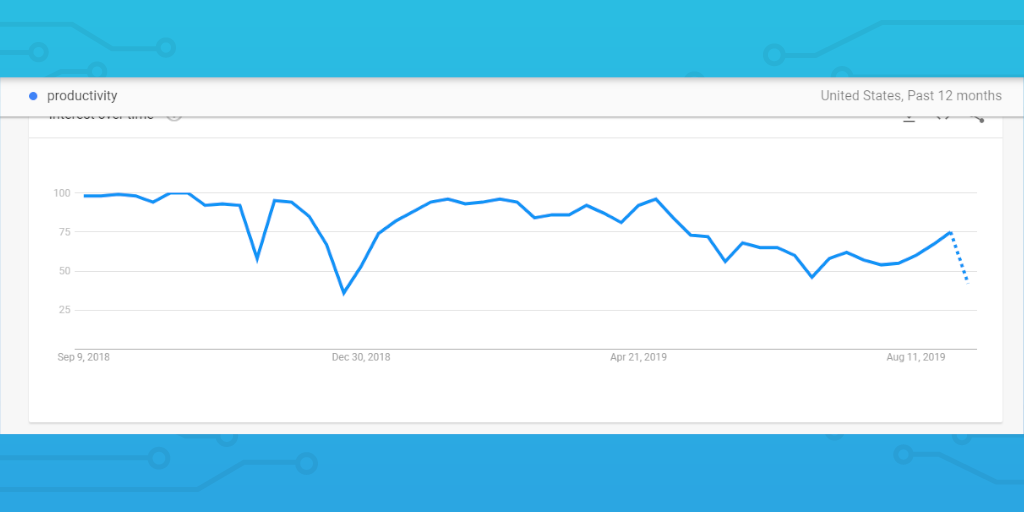
According to Google Trends, the interest in productivity peaked in September 2018. While it has sustained some lows, the idea continues to gain attention as we speak.
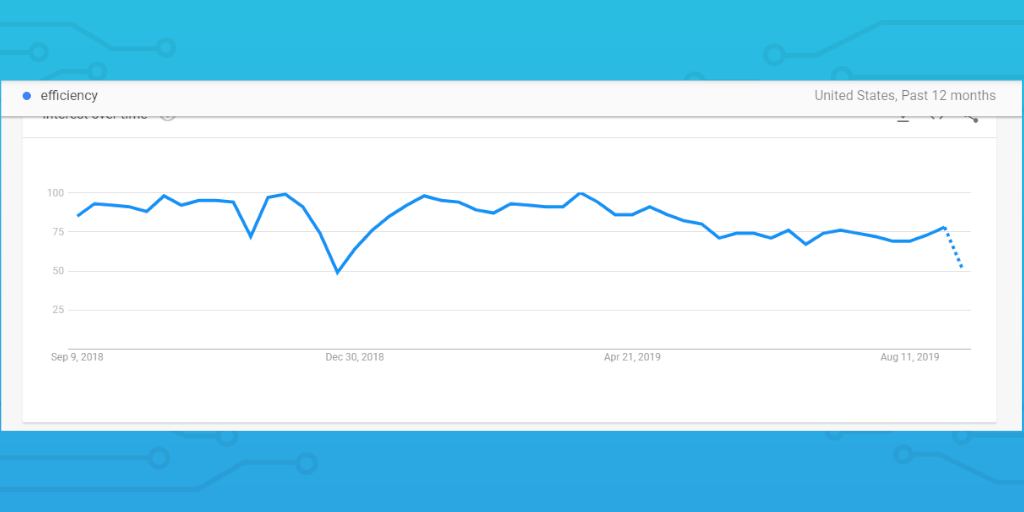
Efficiency, like productivity, also enjoys high volume searches in the US.
Turning a blind eye on the impact of social media and relevant efficiency killers is counterproductive. Surely, limiting access to Facebook, Twitter, and other sites that compel browsing during office hours can help. Plus, smartphones have to go or be kept out of reach to avoid looking at it every 20 minutes.
It makes even more sense to face the battle head-on, combat technology with technology. Companies can focus their energies on speeding up, streamlining, sorting processes so that people have less time to wonder and wander about in the office.
That’s not to say that you’ll always be able to tell why your productivity plummets.
Every workplace is different, and so are the people that populate it. However, office culture and personal quirks aside, this article will count exemplary technologies and tools that harness, not hinder, workplace productivity.
If you’d like to skip ahead then feel free to use the links below:
- 1. A reliable, fast connection goes a long way
- 2. A project management tool tracks everything
- 3. A time tracking tool gives control
- 4. A chat app provides quick, real-time updates
- 5. Teleconference Equipment Links Teams
- Working with technology is the new productivity
- Boost your productivity today with Process Street!
1. A reliable, fast connection goes a long way
A quality internet connection in the office is a given. People expect to spend the next seven to eight hours feeling productive and accomplishing some things.
However, it’s hard to maintain calm and focus if the office internet is uncooperative. You lose your train of thought in an instant, and it’s hard to regain it when the internet light is back on.
A poor connection is also on a different level from the usual office pet peeves of disappearing donuts and dirty dishes in the sink. It’s difficult to reason with clients that unstable internet is the cause of delay and inefficiency.
How fast is this internet connection? It depends on the business’ daily requirements, including the activities that every person performs. Browsing, video streaming, teleconferencing, and the like will certainly eat up your bandwidth, and they are significant considerations when applying for internet speed.
For your reference, this table summarizes internet speeds, activities along with the number of connective devices:
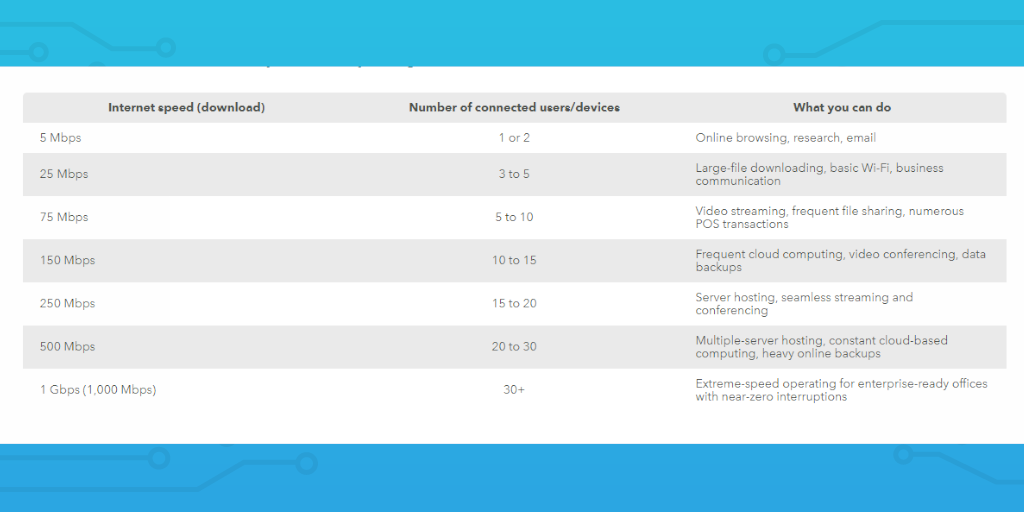
For uninterrupted and high-speed transmission of data, the choices range from DSL, fiber or wireless connection, or a combination of wired and Wi-Fi.
It’s also imperative to set up a backup internet connection just in case your primary network is experiencing intermittent to no connection at all. Nonetheless, you can always allow people to work in their homes should office internet prove to be unreliable. They might be more productive at home, too.
2. A project management tool tracks everything
Whiteboards and markers are useful, but writings using those tools are impermanent, and the context is inevitably lost. No one will correctly remember the details during the meeting because the mind works that way.
As to managing the project per se, think of passing around the gameplan. There will be dissenting opinions and revisions; imagine having to encode and print updated versions as you make progress. There will be lots of paper, time, and put into creating documents that you can do without.
Whether your team consists of two or twenty people, you will need a virtual board that allows real-time collaboration, updating, and reporting.
This work falls under a project management tool that contains what everyone is doing down to the last dot. Each task has a card with details and bullet points and functionality to leave comments and updates. You can move this card from the to-do stack to completion.
Employing a singular tool, be it a simple or sophisticated software, is a straightforward approach to assigning and accounting for every single actionable item that goes into each project. Managers and team leaders can save their energy, inquiring about what things are going on. They can simply head over to the dashboard, click an entry or card.
The move slashes time for unnecessary exchanges, direct reporting, and possibly, micromanagement. Of course, it’s another matter to see a critical task not moving an inch since its assigned date.
Examples of project management software are the following:
- JIRA allows you to create sprints, which are specific periods to complete tasks with corresponding story points
- Process Street lets you create checklists that you can tick every time you finish a task. It lets you break down a huge assignment into bite-sized chunks containing instructions in every step – it’s project and process management built into one easy-to-use tool
- Asana offers a user-friendly interface to view new, in-progress, and completed tasks in one sitting
- Trello takes simplicity in project tracking to another level, as summarized in “To Do”, “Doing”, “Done”
- Google Sheets doesn’t work like the three above but provides a free and straightforward tracker for editing and updating in real-time
- Zoho presents a suite of solutions, including interactive spreadsheets and documents
Perhaps, the greatest boon of adopting a project management tool is to have access to numbers. Some of these software programs can support integration with time-tracking software.
3. A time tracking tool gives control
It ties in neatly with a seamless and organized workplace that has a quantifiable and verifiable system of monitoring of tasks. The time-tracking tool will record the minutes or hours spent on an item. It can generate reports to track the time in a matter of weeks or months and paints a larger picture.
Productivity goes with maximizing time to achieve goals. And while there is more to time management, a knack for keeping track of the hours is a step toward a productive day.
With a timer on your phone or computer, there are three expected outcomes:
- Make you conscious of time usage
- Motivate you to work efficiently
- Manage your time wisely
Whether that is the standard for you or that job has dragged on, that’s for you to decide. As you gain a good grasp of your pace shown on the timesheets, you can devise ways to work your way around your day.
On the side of management, they want to see what everyone is doing while on the clock. Time-tracking tools can offer analytics that aggregates data and turns them into useful insights, such as for identifying strengths and weaknesses and setting goals along realistic lines.
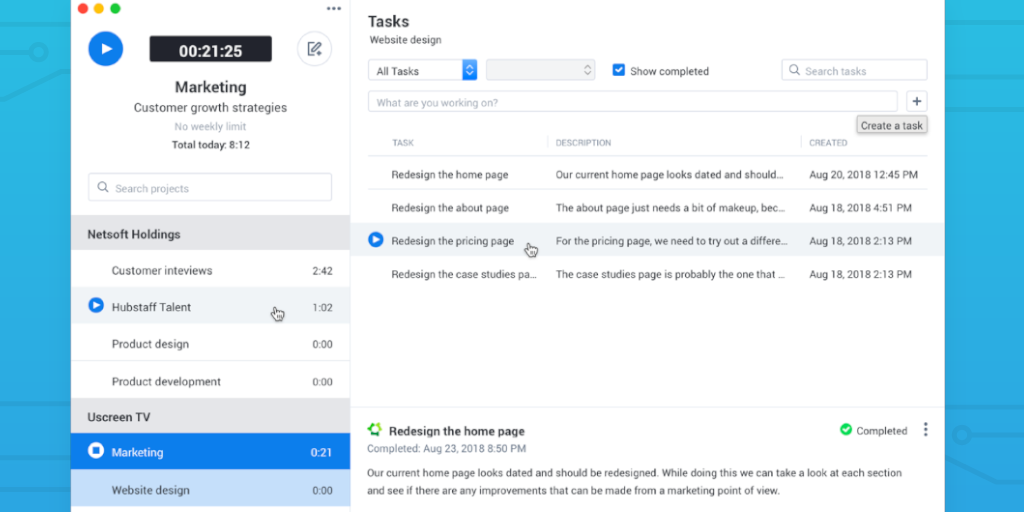
An example of time entry on Hubstaff as taken from its website.
To be fair, time-tracking tools are not the be-all and end-all of productivity. As some people contend, it isn’t just about getting work done but gaining satisfaction and fulfillment as well.
As a colleague once said of a certain time-tracking software, it doesn’t measure the hours she’s spent figuring out what to do with her task.
A shout-out to Pomodoro
All this talk about time and productivity inevitably brings up Pomodoro, which has received rave reviews from users who swear by its ability to help them focus. The Pomodoro technique moves away from the concept of a ticking clock that only induces anxiety and ultimately leads to procrastination.
Instead, the technique suggests working in increments of 25 minutes. Go to the tracker, input your task, toggle the kind (personal or work), and hit the Start button on the tracker itself.
Spend the next 25 minutes without interruption or commercial break. Stop. Did you finish the task? If not, you can always restart the timer. Work again for 25 minutes, stop, take a break.
Rinse and repeat. Pat yourself on the back for immersing in real work.
A shout-out to BeeBole
It isn’t just your own work you might want to track.
The thing about being in the workplace is you’re not doing things alone. You need to all function well as a team and be able to stay in synch.
This is where it becomes really useful to have a time-tracking/timetable kind of system in place. Whether you’re in a virtual office, operating with policies of flexi-work, or trying to organize shift schedules, it’s really handy to be able to look at people’s work patterns and know who is doing what when.
For this, it’s worth checking out BeeBole.
4. A chat app provides quick, real-time updates
Communication, collaboration, and coordination are catchphrases, but they make capable and agile teams. Members work toward the same goal, and it will help things if people know what they’re doing and deal only with the relevant and latest information.
Aside from emails and meetings, messaging apps have a special spot in company communication for things that need to be said, shared, and acted upon stat. There’s no better way to alert your coworker of a problem than sending a message.
The likes of Slack, Skype, Discord, and Google Hangouts call the shots of the day-to-day affairs in the office, filled with unexpected events at short notices. Imagine a boss who sends out messages to change this and that at the most critical hour. Chats deliver this sense of urgency.
What makes instant messaging an indispensable communication tool for business?
- It does away with the rigidity of emails. Everything about writing emails takes time, not to mention that recipients can miss them out even with the word important in the subject line
- It takes less bandwidth. Why call when you can communicate through chat?
- It gets a quick reply. As fast and as short your message is, so is the response. You can also see if the other person is typing or has seen the chat
- It keeps history. Whether you are out or doing something else, you can backread to check what you may have missed
- It organizes people or topics. Channels, rooms, and threads ensure the presence of members involved in the matter and that they stay on track and within the subject
- It simplifies the often-convoluted communication in the workplace. Official communications leave many things unsaid, and chats provide the best avenue to clarify things
Each instant messaging app has its array of features, including sharing files, conferencing, and adding bots that can stack up to your organization’s needs.
Above all else, instant messaging offers a direct and casual way to communicate between coequals or with bosses, which can build trust and rapport. One barrier to communication is the feeling of intimidation when talking to a superior, and chatting with emojis can help climb over that wall.
5. Teleconference equipment links teams
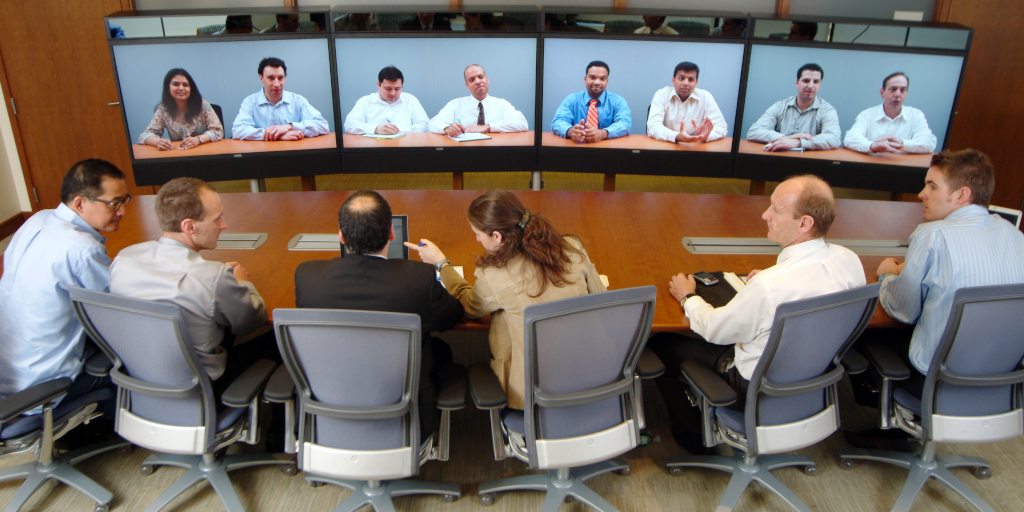
Teleconferencing is a fact of today’s office life. It renders commuting and traveling to meet in person and share information cumbersome and obsolete.
Effective communication is, after all, indispensable to the successful outcome of a project. Organizations with remote, outsourced, and in-house teams are the primary beneficiaries of video conferences and audio conferences, never minding the geographical barriers and time
zones.
Furnishing a conference room is doable with pieces of equipment to host or participate readily available. What you’d be looking at is the cost of putting them all together.
- Laptops are easy pickings for calls with their built-in cameras and microphones. They are ultraportable, second to smartphones. Depending on the virtual meeting software, screen sharing, live editing of documents, and presenting are the norm.
- Smartphones spell convenience for entrepreneurs and employees who are always on the move. All other things being equal, using a smartphone for calls is not as taxing to the internet as is a laptop with its multiple processes running in the background.
- Conference phones are legends in the field, having been in the business of teleconferencing for a long time. While these phones seem to look out of place in a world that is a Skype call away, their audio quality is unmatched. Conference phones have also been at the receiving end of innovation with VoIP capability, LCD display, and more.
Indeed, video conferences and audio conferences continue to expand their reach to other sectors aside from business, like health and education. All these technologies to integrate voice and video pave the way for meaningful interaction at meetings and huddles.
Web conferencing brings people from diverse geographical locations for a productive discussion. Meetings, however, have been named the black sheep of work tasks and a hindrance to deep work.
The timing, frequency, and the agenda or the lack of such sessions tend to work against productivity. A common complaint of having too many meetings in a week is that it wastes time and steals focus from the pressing matters.
Workplace productivity: How to make meetings more productive
Against the bleak backdrop noted above and to restore the glory of meetings, which, to be fair, still hold merits if put into good use, think of these initiatives:
- Meet within the allotted time. Set the timer to 30 minutes or less to cover the topics and cut back on unnecessary chatter
- Huddle once or twice a month. Unless it’s an emergency, email and chat will suffice
- In any gathering that involves technology, make the necessary preparation and testing to avoid wasting time because of technical difficulties
- Maximize brainstorming sessions by preparing ideas and doing research about them in advance. It steers the discussion to the right course and saves the trouble of checking Google on the spot
Working with technology is the new workplace productivity
For the longest time, workplace productivity has been tied to the number of hours put into work. The idea is that it is okay to toil beyond the shift to hit the benchmarks or reach a higher output. Over time, this can lead to a lack of work-life balance and burnout.
Whether one spends eight hours or more at work, the results are startlingly similar. On an eight-hour workday, these are the results:
- Americans are productive three hours a day on average
- Office workers in the UK’s productivity average out at two hours and 23 minutes
The key takeaway here is to leverage technology and automation such that the manual and administrative side of doing things are taken care of and the focus goes solely on the creative and collaborative aspects.
- With a click or tap, you can assign tasks on the project management tool for the day, the week, or the whole month and track the progress and tag the person in charge
- Should you have questions or need to discuss further, you can jump on a quick call or chat online
- Employ a time tracking tool to instill accountability and responsibility, and more importantly, effective use of time within the time
- Ensure you have the most reliable internet connection for uninterrupted and efficient work
You might not be able to totally eliminate distractions, but you can minimize them when you put in place clear-cut and user-friendly solutions as noted above. These initiatives will remove the guesswork that so often leads the brain to wander and distract itself.
In essence, you are empowering your team by equipping them with modern tools to make their work easier, faster, and more efficient. You’re giving them the best organization apps to work with.
Boost your productivity today with Process Street!
Process Street is the best piece of BPM software on the market. To put it bluntly, it lets you create and run superpowered checklists to track what your team does while guiding their methods.
In other words, you can wave goodbye to human error.
By building out your SOPs (standard operating procedures) as templates within Process Street you provide your team with an easy way to see what tasks they need to carry out and how they should be completed.
“What’s so special about that?”, I hear you cry, “I can write down a task list in Word and have my team read it without using a different program”.
True, but can you track their progress from anywhere at any time? Can you see when each task was completed and who took part in the process? Can you assign different team members to specific tasks in the same process? Can those team members immediately know when they’re needed to take action without the delay of messages or talking in-person?
Can your process adapt to a situation on-the-fly to provide accurate instructions no matter the circumstance?
No. You can’t do all of that. But with Process Street, you can.
You need to be digitalizing workflows.
Checklists can be run from your process templates to track individual instances of a certain process in action. These can be assigned to your team members via a whole checklist or through individual tasks to delegate the workload.
Better yet, these assignments can all happen automatically! That means no-one in your team can be said to not have access to their instructions or have any reason to lose their way and either forget a step in the process or delay out of confusion.
Stop wasting time with inefficient workflows and learn how to create processes to supercharge your team. Sign up for a free trial today!
Do you have any productivity tips to share? Let us know in the comments below!







 Workflows
Workflows Projects
Projects Data Sets
Data Sets Forms
Forms Pages
Pages Automations
Automations Analytics
Analytics Apps
Apps Integrations
Integrations
 Property management
Property management
 Human resources
Human resources
 Customer management
Customer management
 Information technology
Information technology



Ben Mulholland
Ben Mulholland is an Editor at Process Street, and winds down with a casual article or two on Mulholland Writing. Find him on Twitter here.